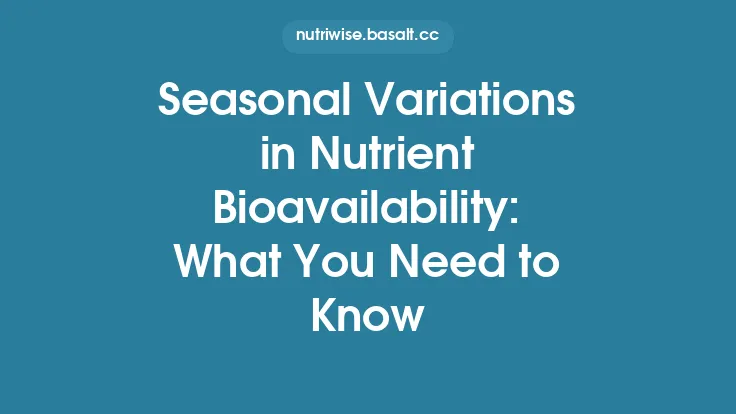Protein is one of the three macronutrients that our bodies rely on for growth, repair, and countless biochemical processes. While the total amount of protein you consume is important, the *type* of protein matters just as much. In the world of nutrition, proteins are often classified as either complete or incomplete, a distinction that can influence dietary planning, especially for those following vegetarian, vegan, or mixed‑diet regimens. Understanding this classification helps you ensure that you’re getting all the essential building blocks your body cannot produce on its own, without having to obsess over exact numbers or timing.
Below, we’ll explore what defines a complete protein, where you can find them, how to work with incomplete proteins, and practical strategies for creating a nutritionally balanced diet that meets your needs for life’s many stages.
What Makes a Protein Complete?
A protein is deemed complete when it contains sufficient quantities of all nine essential amino acids (EAAs) in proportions that meet human physiological requirements. The essential amino acids are:
- Histidine
- Isoleucine
- Leucine
- Lysine
- Methionine (often considered together with cysteine)
- Phenylalanine (often considered together with tyrosine)
- Threonine
- Tryptophan
- Valine
These amino acids cannot be synthesized by the body and must be obtained through diet. A complete protein provides each of them in amounts that, when consumed in typical serving sizes, support normal protein synthesis, enzyme production, and neurotransmitter function.
The concept of “completeness” is rooted in protein quality—the ability of a protein source to meet the body’s amino acid needs. While the term “protein quality” is explored in depth elsewhere, it is useful to note that completeness is a practical shorthand for high-quality protein, especially when planning meals without sophisticated laboratory analysis.
Common Sources of Complete Proteins
Animal‑Based Options
Animal products naturally contain all EAAs in the right ratios, making them reliable sources of complete protein:
| Food Group | Typical Serving (approx.) | Complete Protein Content |
|---|---|---|
| Meat (beef, pork, lamb) | 3 oz (85 g) cooked | 20–25 g |
| Poultry (chicken, turkey) | 3 oz cooked | 20–25 g |
| Fish & Seafood (salmon, tuna, shrimp) | 3 oz cooked | 20–25 g |
| Eggs | 1 large egg | 6–7 g |
| Dairy (milk, yogurt, cheese) | 1 cup (240 ml) milk or 1 oz cheese | 8–10 g |
These foods are also rich in micronutrients such as vitamin B12, iron (heme), zinc, and omega‑3 fatty acids (particularly in fatty fish), which can complement the amino acid profile.
Plant‑Based Options
Only a handful of plant foods naturally contain all EAAs in adequate amounts:
| Plant Source | Typical Serving | Complete Protein Content |
|---|---|---|
| Soybeans (edamame, tofu, tempeh) | ½ cup cooked | 10–15 g |
| Quinoa | 1 cup cooked | 8 g |
| Buckwheat | 1 cup cooked | 6 g |
| Amaranth | 1 cup cooked | 9 g |
| Hemp seeds | 3 tbsp | 10 g |
| Chia seeds | 2 tbsp | 4 g |
Soy, in particular, stands out as a versatile complete protein, available in multiple forms that can be incorporated into a wide range of dishes. Quinoa and the other pseudocereals provide a grain‑like texture while delivering a full amino acid profile.
Understanding Incomplete Proteins
Most plant foods—such as legumes, nuts, seeds, grains, and vegetables—are incomplete proteins, meaning they are low in one or more EAAs. For example:
- Legumes (beans, lentils, peas) are typically low in methionine and cysteine.
- Cereals (wheat, rice, oats) often lack sufficient lysine.
- Nuts and seeds may be limited in lysine or threonine.
This does not make them “inferior.” Incomplete proteins still contribute valuable amounts of protein, fiber, healthy fats, vitamins, and minerals. The key is to balance them throughout the day so that the missing amino acids from one source are supplied by another.
Strategic Pairing: Complementary Proteins
The classic solution to incomplete proteins is protein complementarity—combining two or more plant foods that together provide a full set of EAAs. When paired correctly, the limiting amino acid in one food is compensated by the other.
Classic Complementary Pairings
| Pair | Limiting Amino Acid in Food A | Complementary Amino Acid in Food B |
|---|---|---|
| Beans + Rice | Methionine (beans) | Lysine (rice) |
| Hummus (chickpeas) + Whole‑grain pita | Methionine (chickpeas) | Lysine (wheat) |
| Peanut butter + Whole‑grain bread | Methionine (peanuts) | Lysine (bread) |
| Lentils + Quinoa | Methionine (lentils) | Lysine (quinoa) |
| Almonds + Soy milk | Methionine (almonds) | Lysine (soy) |
The beauty of complementary proteins is that they do not need to be consumed in the same meal. As long as a variety of protein sources are eaten throughout the day, the body can pool amino acids from the digestive pool to meet its needs.
Practical Tips for Complementary Eating
- Plan meals around a grain and a legume: A bowl of brown rice topped with black beans, or a lentil stew served with whole‑grain naan, automatically creates a complete profile.
- Add a handful of nuts or seeds: Sprinkle pumpkin seeds on a quinoa salad or blend almond butter into a smoothie with oat milk.
- Use soy products as a “protein anchor”: Tofu, tempeh, or soy yogurt can fill gaps when paired with other plant foods.
- Think of snacks as opportunities: A piece of whole‑grain toast with hummus, or a trail mix of dried fruit, nuts, and soy crisps, can contribute to the daily amino acid balance.
Practical Tips for Building a Balanced Protein Profile
- Diversify Your Protein Sources
Aim for at least three different protein foods each day. This naturally spreads the amino acid intake and reduces reliance on any single source.
- Mind Portion Sizes
While a single serving of a complete protein (e.g., 3 oz of chicken) provides roughly 20 g of protein, plant‑based servings often require larger volumes to reach the same amount. Adjust portions accordingly, especially if you have higher protein needs (e.g., athletes, older adults).
- Incorporate “Protein‑Rich” Vegetables
Vegetables such as broccoli, Brussels sprouts, and spinach contain modest amounts of protein and can contribute to the overall total when eaten in generous portions.
- Leverage Fortified Foods
Some plant milks, breakfast cereals, and meat analogs are fortified with additional EAAs, making them closer to complete proteins. Check nutrition labels for “complete protein” claims.
- Track, Don’t Obsess
For most healthy adults, simply ensuring a variety of protein foods across the day is sufficient. Detailed amino acid tracking is generally unnecessary unless you have specific medical or performance goals.
Considerations for Specific Populations
| Population | Key Considerations | Suggested Strategies |
|---|---|---|
| Children & Adolescents | Rapid growth demands adequate EAAs. | Prioritize complete proteins (e.g., dairy, eggs, soy) and ensure diverse plant sources for vegetarians. |
| Pregnant & Lactating Individuals | Increased protein needs and higher demand for lysine and methionine. | Include at least one complete animal or soy protein daily; supplement with legumes and whole grains. |
| Older Adults | Sarcopenia risk; need higher protein quality to support muscle maintenance. | Emphasize complete proteins (lean meats, fish, dairy, soy) and consider protein‑rich snacks. |
| Vegans | No animal‑derived complete proteins. | Rely on soy, quinoa, buckwheat, and strategic complementarity; consider fortified foods or supplements for B12 and possibly lysine. |
| Athletes | Higher total protein intake; timing less critical than overall daily amount. | Use a mix of complete animal proteins and plant‑based combos; incorporate post‑exercise meals with soy or whey for rapid amino acid delivery. |
Environmental and Ethical Perspectives
Choosing between complete and incomplete proteins can also intersect with sustainability goals:
- Animal‑based complete proteins generally have a higher environmental footprint (land use, water consumption, greenhouse gas emissions) compared to most plant proteins.
- Soy is a plant‑based complete protein with a relatively efficient protein yield per hectare, though concerns about deforestation in certain regions highlight the importance of sourcing responsibly.
- Legume‑grain combos (e.g., beans + rice) not only provide complete amino acid profiles but also improve soil health through nitrogen fixation, reducing the need for synthetic fertilizers.
When environmental impact is a priority, focusing on plant‑based complete proteins (soy, quinoa) and complementary pairings can deliver nutritional adequacy while supporting more sustainable food systems.
Frequently Asked Questions
Q: Do I need to eat a complete protein at every meal?
A: No. The body maintains a circulating pool of amino acids, so as long as you consume a variety of protein sources throughout the day, you’ll meet your essential amino acid requirements.
Q: Are protein powders “complete”?
A: Most whey, casein, and soy protein isolates are complete because they are derived from complete protein sources. Plant‑based blends (e.g., pea‑rice) are often formulated to be complete as well.
Q: Can I rely solely on incomplete proteins if I’m vegan?
A: Yes, provided you combine different plant foods over the course of the day to cover all EAAs. Many vegans meet their needs without ever consuming a single “complete” plant protein.
Q: How does cooking affect protein completeness?
A: Heat can denature proteins, altering their structure, but it does not remove essential amino acids. Cooking may improve digestibility, making the amino acids more accessible.
Q: Is “complete protein” the same as “high‑quality protein”?
A: They overlap. A complete protein contains all EAAs, which is a major component of protein quality. However, protein quality also considers digestibility and the proportion of each amino acid relative to human needs.
By understanding the distinction between complete and incomplete proteins, you can craft meals that are both nutritionally sound and aligned with your personal preferences—whether you favor animal products, plant foods, or a blend of both. The goal isn’t to chase perfection in every bite, but to ensure that over the course of a day, your diet supplies the full suite of essential amino acids your body needs to thrive.





